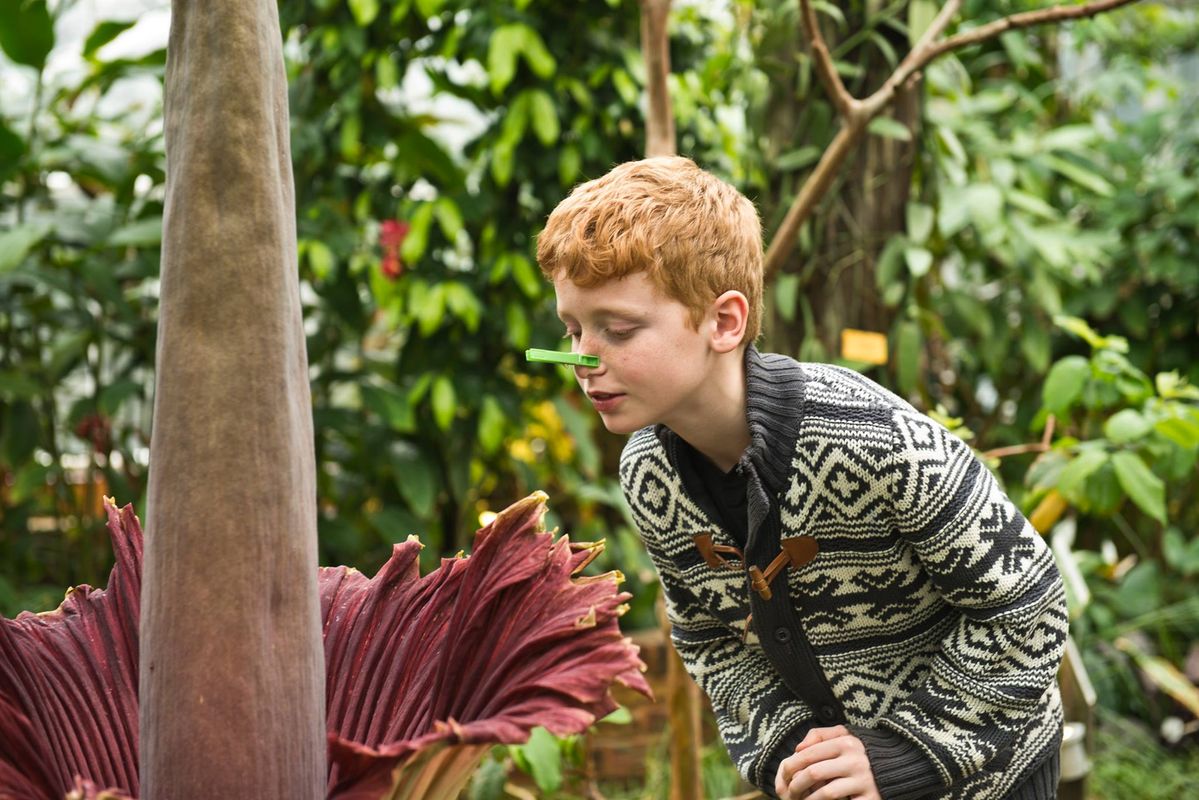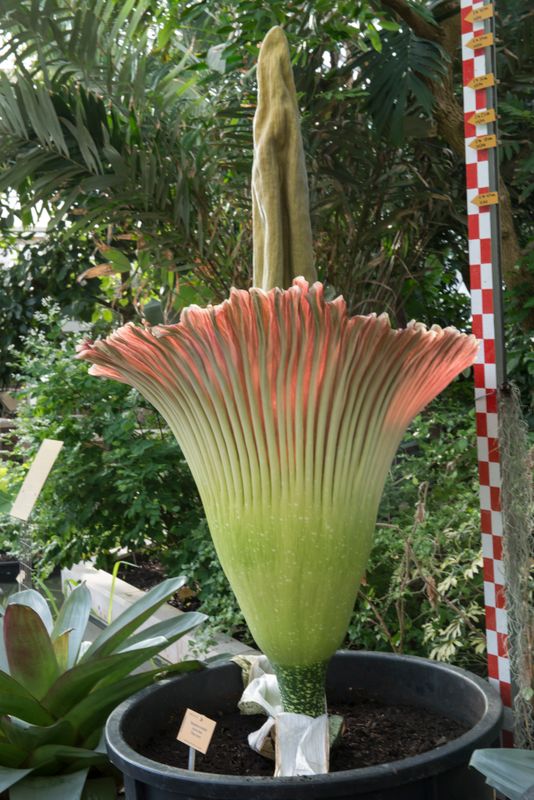Titan arum
We're expecting a giant arum to flower soon!
If you would like to be informed as soon as the flowering starts of the next titan arum, please sign up for our mailing list and you will receive an email as soon as the show starts at the next flowering.
The secret life of the titan arum
Everything big
The titan arum was discovered in the steamy rainforests of Sumatra by the Italian botanist Odoardo Beccari in 1878. The plant requires a high level of humidity and a constant heat of at least 24 °C. During one growing season, the large tuber, which can become as heavy as 130 kg, produces either a huge 2 to 6 m high leaf or a giant 1.5 to 3 m high ‘flower’. Botanically speaking, it is an inflorescence, given that it is composed of many small flowers.
A shameless pillar
The inflorescence consists of a giant upright yellowish flowering spadix - its scientific name Amorphophallus titanum literally means deformed giant penis - surrounded by a dark red spathe with graceful folds. At the base of the spadix, there is a band of small pinkish female flowers with a strip of pale yellow male flowers above it. Once the female flowers are ready for pollination, the spadix warms up and begins to emit a disgusting scent that is somewhere between a cadaver, rancid cheese and rotten fish. This is why the Indonesians call it the ‘corpse plant’.
Ingenius reproduction
Like all plants, the titan arum blooms in order to reproduce. Pollen must be brought from one plant to another. However, in nature the plants grow far apart and bloom only rarely; on average every three years. Furthermore, they flower for a mere 72 hours, after which the inflorescence dies off. The plant must be pollinated during that short period. Which explains the plant’s incredible fragrance.
A swarm of sweat bees
The scent attracts sweat bees from far and wide, which believe they have found a cadaver. Some will have just visited another distant titan arum and are still covered in pollen. They descend deep into the inflorescence, thereby pollinating the female flowers. The shape of the inflorescence prevents them from immediately escaping. Many hours later, the male flowers are ripe and release their pollen. The pollen-covered bees subsequently follow the scent of another titan arum located kilometres away and the story repeats itself. The fertilised female flowers grow into red berries that are eaten by birds, which go on to spread the seeds through their faeces.
Good news for threatened species
Half of the island of Sumatra has already been deforested, as a result of which the population of orangutans has decreased by 80%, and the situation of the titan arum is not much better... Today, botanical gardens are getting increasingly better at cultivating the titan arum. Which increases the chances of survival of this plant species. The specimen now in bloom was sown by Botanic Garden Ghent in 2005 and came to the Botanic Garden in 2014. Exchanges between different botanical gardens worldwide help promote genetic diversity.
Titan arum in Meise Botanic Garden
Getting a titan arum in bloom remains a rarity. Thanks to the skill of our gardeners, who pamper and care for our titan arums, we now have five healthy adult specimens in the collection. Of these, one or more alternate blooms every year, which is no mean feat. Only with the right temperature, humidity and nutrition will you achieve this beautiful result. In Botanic Garden Meise, thanks to the recently inaugurated Green Ark, we can create the ideal growing conditions. And therefore also conduct cutting-edge research and protection programmes for endangered species such as the titan arum.
Belgian arum
Meise Botanic Garden saw its first titan arum bloom in 2008, attracting more than 8,000 visitors in just a few days. Since then, 20 titan arum calyxes have flowered, attracting large numbers of visitors each time. But did you know that wild arums also grow in Belgian forests? Its small (30 cm) but equally captivating cousin is called the spotted arum (Arum maculatum) and can be seen blooming in old forests every spring, including in the Botanic Garden.






